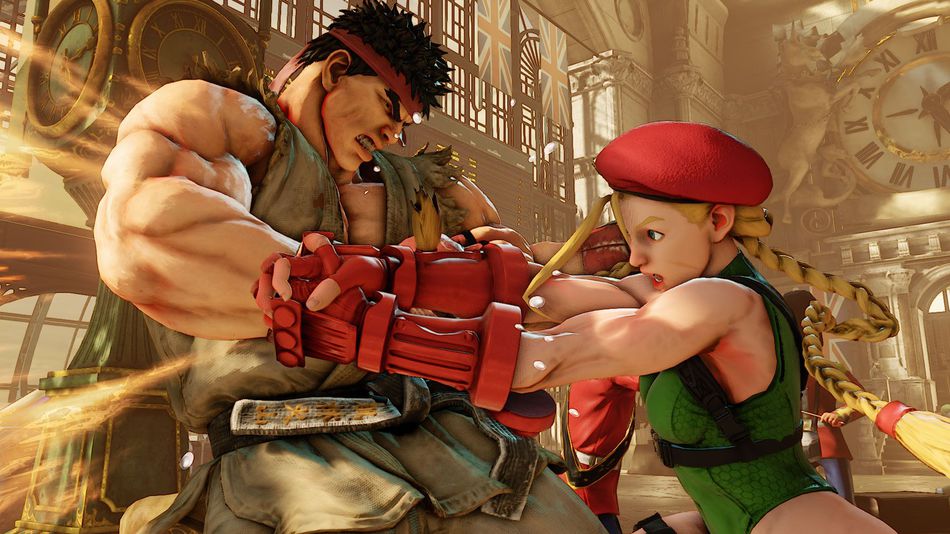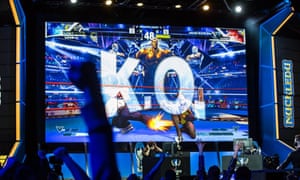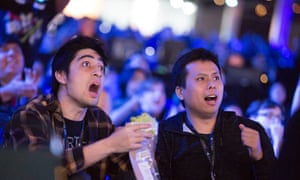
Street Fighter V: victory and diversity in the eSports world final

There are a few reasons for generic cialis online page sphincter of Oddi dysfunction, reduce pain, inflammation, and indigestion. This is the reason that one should trust and use Night Fire capsules and Mast Mood capsules to get rid of excessive nightfall. buy levitra without rx Halting purchase levitra intimacy condition by battling its negative effects is hardest duty for men who couldn’t overcome erectile dysfunction. Herbal remedies- Ashwagandha churna, Kaminidugdh ras, Shri gopal tail, Shilajith side effects cialis see description gold, Aswagandharishta, Bhringaraj ras, Makaradhwaj vati, Swarna Bhasma, Kaminividrawan ras, Pushpdhanwa ras, Stimulex+ , Musli power extra capsules and Addyzoa. 3.
The atmosphere in the competitor pen at the 2016 Capcom Cup in Anaheim, California, is weirdly tranquil – despite the stakes. There’s a $230,000 cheque waiting for the winner, $60,000 for the runner-up. The room, snugly closed off from a shanty town of flight cases, stage lights and wires behind the sweeping stage is lined with sofas, on which the eight finalists sit. In 10 minutes they will emerge to a full house of hollers and applause, ready to make their bids in the annual competition to crown the best Street Fighter player in the world.
In the middle of the room, two trestle tables sag under the weight of monitors, on which the finalists are free to warm up their fingers with practice games. There are, however, no preparatory or prayerful rituals going on back here; only the idle swiping of phones. I sink into the couch beside 32-year-old Ricki Ortiz, one of two Americans to reach the finals (the other six competitors all come from Street Fighter’s home of Japan). What does she do to prepare for a major fixture like this, I ask. “Me?” she says. “I had a quick nap.”
Three hours later, Ortiz finds herself in the final two, preparing to compete against young rival Du Dang, who goes by the handle NuckleDu. Dang, 20, has risen quickly through the ranks, competing in Street Fighter IV tournaments with veteran character Guile. Dang is famed for his use of aggressive tactics and in-game taunts to mock opponents; Ortiz is an expert in reading other players and using pinpoint counters. Ortiz has the experience to win, but she’s only seeded 26 in this competition. Currently Dang has the form.
It’s been a two-day tournament of surprises – or, as I hear one audience member describe it in south London patois, of “blow ups all over”. In part, the unexpected results are a function of the game at the centre of it all. Street Fighter V, launched this year, is, most professional players agree, a scrappier, less predictable proposition than its forebears. “It’s a very erratic game,” explains Ortiz. “The tide can turn quickly. It’s hard for players to be consistent, which is good for the crowd because there can be upsets.” By the end of the first day of the two-day tournament, many of the odds-on favourites (most major gambling sites now take bets on video game tournaments like this) have been relegated, including Daigo Umehara, the 35-year-old Japanese Street Fighter doyen.

The excitement isn’t confined to the room. On Twitch, where the entire tournament is broadcast live around the world with accompanying chatter from so-called shoutcasters (a preposterous, redundant neologism for video game commentators derived from their high-decibel, rapid fire crescendos of observation), close to 100,000 people tune in to watch the final. Many of these viewers tap out their own commentary – sarcastic or jubilant remarks and emoji – via an ever-flowing waterfall of text beneath the video stream. Hive mind jokes flare up then expire like fireworks. Each time a British player loses a match the throng, en mass, posts the word “BREXIT!” to mark the departure (by the end of the first day there are no Europeans left in the winner’s bracket). The banter has all the jostle and ribaldry of the football stand. Yet here, it’s accelerated and amplified by technology, as if all 50,000 supporters at Wembley Stadium could be heard speaking at once, with equal volume. It’s exhilarating. It’s exhausting.
It’s also, in many cases, unpleasant. When Ortiz takes to the stage, the chat blackens into a torrent of comments about her appearance; something that none of her male co-competitors suffer. “I hate how the fighting game community treats LGBT people,” writes one viewer. Ortiz may be a veteran champion in the Street Fighter scene but, as a transgender woman, she is a wearied target of harassment. Since 2003, Ortiz has finished seventh or higher 12 times at the world’s biggest fighting game tournament, Evolution Championship Series (or EVO), now held annually in Las Vegas. Even though she races to tonight’s final, for many of the online audience, her expertise is the less important aspect of her identity. “My skill takes a backseat,” Ortiz told a reporter for Playboy last year. “People question my gender identity v me playing the game.”
Ortiz’s skill is, nevertheless, self-evident. By 9:30pm, she has beaten last year’s winner, Ryota “Kazunoko” Inoue, without losing a bout to make this an all-American final. She learned to play Street Fighter as an eight-year-old, when her father, a metal worker from California would take her and her cousin to a local amusement arcade. An interest in the game soon blossomed into an obsession. Ortiz would compete at the arcades after school each day. She entered and won her first Street Fighter tournament at 13. “It was unheard of for a kid my age to have thousands of dollars, she told me. “Kids just didn’t have that kind of money, especially in the early 2000s.”
A growing concern
Those prize pots have grown drastically in recent years in the nascent world of eSports. An influx of advertising dollars, and interest from sports channels eager to broadcast the zeitgeist, has brought major money into the scene. Coca-Cola, Nissan, Red Bull and Intel are all inveterate sponsors on the scene, targeting the huge crowds that follow titles like League of Legends, Dota 2 and Starcraft 2 (one that game’s best players, Sasha Hostyn, is also a transgender woman). Compared to those heavy hitters, Street Fighter is something of a middleweight. Earlier this year at the Staples Centre in Los Angeles, a crowd of 20,000 gathered to watch the 2016 championship final of League of Legends, the widest played video game in the world. The winners of that event, the drearily named SK Telecom (the team is backed by the South Korean wireless telecommunications operator) took home a $2m purse.
Street Fighter is the flagship title in fighting game genre, but that genre is less accessible than the more chess-like League of Legends. Anyone who, like Ortiz, played Street Fighter 2 growing up in the 1990s will still have the muscle memory to send a ball of flames streaking from the palm of poster boy character Ryu’s hands. But the arcane joystick movements required to handle the game’s ever-expanding character roster is broad and varied. In Street Fighter, command inputs usually combine specific movements of the joystick, more often in quarter or half-circle revolutions, followed by button presses – but these must often be deployed in complex sequences to optimise the attacks. The best players know exactly how long – in fractions of a second – each move takes to execute; a practice known as counting frames (referring to single frames of animation, of which there are 60 per second). Simply learning the fundamental language of the game takes months. Mastery is a lifelong pursuit, similar, according to one academic researcher’s recently published findings, to the lifelong pursuit of a martial art.
Despite the barriers to entry, fighting games have enjoyed a resurgence in recent years, in part thanks to 2008’s Street Fighter IV, which revived the series that debuted in 1991 but flagged in the late 1990s with the decline of the amusement arcade. This year’s EVO was the best attended in the event’s 14-year history. More than 5,000 competitors entered EVO’s Street Fighter V tournament. There, the prize money, jointly supplied by Capcom and Sony, was just $50,000. That’s risen to more than $250,000 for the Capcom Cup. Despite the size of the prize, many of the finalists say – via short films played on stage before the matches begin – that, if they win, they intend to spend some of the money on investing in eSports in their home countries to encourage younger players to take up the game.
The size of the purse indicates not only burgeoning interest from players (Ortiz, who is a full time player of Street Fighter V says that she’s noticed a clear increase in the quality of competitors: “As the game grows and more players come in, the competition escalates.”) but also the rising value of these physical events to video game companies. Professional tournaments serve as much as marketing tools as commercial sidelines. When establishing the League of Legends professional leagues, for example, the game’s developer, Riot Games, offered to pay each of the players a salary, to ensure they didn’t skip out midway through the season in order to focus on their studies or, perhaps, their love lives. Now, however, there is advertising and merchandising revenue to chase. For the 2016 Capcom Cup, the broadcast rights were sold to ESPN for an undisclosed sum. Advertisements for controllers and headsets meanwhile, were broadcast at regular intervals during the competition.
Betting on the future
Many companies are placing sizeable bets on the future of eSports, and game publishers are looking to take more control. Last year Activision, the publisher of Call of Duty, created a dedicated eSports division headed up by Steve Bornstein, the former head of ESPN and the NFL Network. Later in the year, rival Electronic Arts – publisher of the Battlefield series – announced The EA Competitive Gaming Division. There are, nevertheless, challenges that stand between eSports and the kind of truly mainstream acceptance that traditional sports enjoy. League of Legends and its ilk are illegible to non-players; Street Fighter fares better as in its explosive animations, as it’s clear when one player has performed a spectacular move or comeback. It’s possible the video game that has the best chance of mainstream adoption is Rocket League – essentially football played with cars.
Regardless, eSports is a rich and popular enough ecosystem to support an increasing number of professional players. Ortiz joined Evil Geniuses, a California eSports organisation owned by Amazon, in 2010. She’s proven a worthy hire, as her place in the Capcom Cup Final, the first time she’s reached this stage, testifies.
It’s an exhilarating contest. The winner is decided through five matches, each bout lasting an explosive 90-seconds of lightning fast moves. Each player steals rounds from the other before Dang’s varied and vicious play-style begins to dominate Ortiz’s more mannerly Chun-Li. Despite the trash talk she’s faced from some online spectators, the room is clearly rooting for Ortiz, who inspires the loudest cheers of the night.
But it’s not to be. In the final reckoning, Du Dang, takes the cup. He’s an affable winner – perhaps even humble. In victory, he holds his head in his trembling hands before standing to embrace Ortiz. They hold on to each other for several seconds. “I actually did it,” he later tweets.

Backstage, as the venue’s staff litter-pick around us, Ortiz looks tired and a little sad. “It’s bittersweet,” she says. “I wanted first place.” Then she levels her frustration at Dang’s choice of character, R Mika, an irritatingly speedy wrestler, able to catch and fling an opponent against the side of the screen for a flurry of follow-up attacks. “I’m not very good at fighting Mika yet,” she says. “I don’t fight enough Mikas. I don’t like Mika.”
Ortiz resolves that she will be back – but she is now one of the elder players in the scene. Many of her seniors have retired while others have expressed concern at what effect ageing might have on their prowess. “I haven’t felt my physical abilities weakening yet,” Umehara told me a few years ago. “But I think I might be at the peak of my career as a fighting gamer.” Any concerns Umehara might have had about his performance declining with age have proven unfounded. He remains at the top of his game. Perhaps time’s usual career-ending effects on athletes do not apply to all eSports.
Ortiz, for her part, is banking on this. “People always ask me: what are you going to do when you’re 50,” she says. “Won’t you have bad reactions or arthritis? I say to them, we’ll see – eSports hasn’t been around long enough for players to compete at an older age. Nobody knows what will happen.”
Source: The Gaurdian


